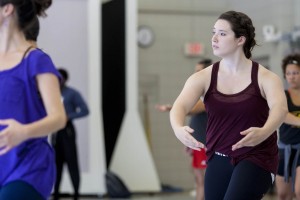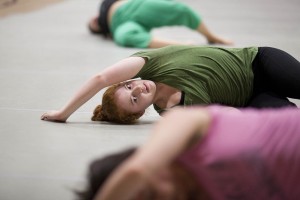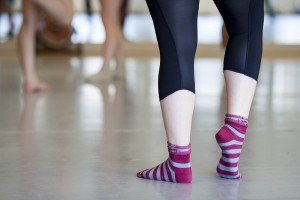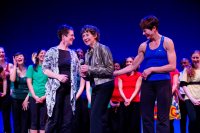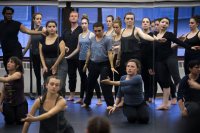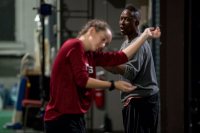
For dance majors, Bates Dance Festival is a chance to visit the dream
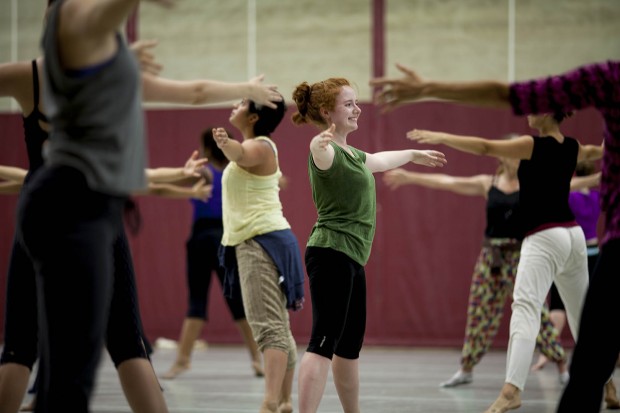
Regan Radulski ‘15 (green top) takes part in a modern-dance class during the Bates Dance Festival. (Sarah Crosby/Bates College)
There’s introducing yourself. And then there’s introducing yourself as a dancer.
On a day in July in a Bates dance studio, a student says her name and makes a little jazzy step. The student next to her says her name and taps her ankle with a flourish. The third says her name and waves a hand dismissively as if to say, “Aw, g’wan,” but with style.
And so it goes, around the circle of 25 or so Bates Dance Festival students, following the teacher’s request that they introduce themselves with a move as well as a name.
It’s an accretive process. After each new ID, all the previous dancers repeat their bit. It takes some time but the result is worth it: By the end, these dancers are getting a pretty good handle on their classmates.
The teacher is Jennifer Nugent, the course is modern dance, the date is July 25 and the place is the Marcy Plavin Dance Studio.
A Bates legend, Plavin founded both the dance festival, in 1982, and the college’s academic-year dance program, back in the 1960s. Not surprisingly, the two entities have enjoyed a long partnership.
That partnership became even more meaningful three years ago, when participation in the festival became a requirement for Bates’ then-new dance major, the first dance-only degree program in Maine.
So what do Bates dance majors gain by training at the Bates Dance Festival — specifically in its Professional Training Program, one of the festival’s three age-related educational tracks? (The others are the Youth Arts Program and the Young Dancers Workshops.)
Deep immersion in a world of dance may be the biggest benefit. “Everyone is there for one thing,” says Bates dance program director Carol Dilley. “Everyone is eating, breathing and living dance for three weeks.”
Specifically, Professional Training Program students take four classes a day. They attend the festival’s public performances, which feature prominent, eclectic and innovative artists whom the students also train with and observe at work.
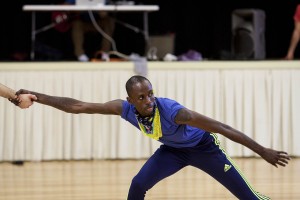
Raja Kelly of David Dorfman Dance at work during the dance festival at New Beginnings in Lewiston. (Sarah Crosby/Bates College)
The students chat, practice, share meals, ice their injuries and hang out with people steeped in dance at all levels, from all angles, from myriad backgrounds and nationalities.
“There is a single-mindedness about dance at the festival that is not possible during the academic year, and a variety of training that a program the size of ours can’t offer through the rest of the curriculum during the year,” Dilley says.
The transformative power of immersion is one of those simple concepts that enfolds an infinity of mutually reinforcing factors. For one thing, immersion makes possible the kind of practice time that builds skills like nothing else — it’s a shortcut to those 10,000 hours reputed to result in mastery of a discipline.
“The festival is very rigorous mentally, very rigorous physically,” says Colleen Fitzgerald ’14, who served as a Young Dancers Workshop counselor this year and then attended the Professional Training Program. Taught by Omar Carrum, the modern-dance course that Fitzgerald took was largely focused on floor work — literally moving around the floor like a starfish, spider or crocodile. Or trying to.
“It’s a technique that probably no one else in the room had ever done. And that’s hard, to try to learn a totally new technique in three weeks.” She adds, “It looked like magic when Omar did it.”
The 2014 festival was the first for Regan Radulski ’15, a double major in biochem and dance (although she has had a work-study job with the festival’s administration). Her festival studies — specifically the Choreo Lab course, similar to the dance department’s composition courses — got her thinking about senior thesis.
“I’m hearing a lot of the same things from a different voice, and also hearing some new things and getting some new ideas,” says Radulski, of Topsham, Maine.
“This past year at school I thought a lot about my opinions on choreography and what I see aesthetically,” she says. “Why do I like a narrative? Do I want the audience to see something abstract? How much do I care about the audience liking the piece, or having any sort of opinion?
“Choreo Lab has been going through a lot of that process, and just condensing it into three weeks, instead of my entire year of thinking.”
As the festival feeds dance majors, it likewise feeds the academic-year dance program itself. “Festival students bring their stepped-up practices back into the studios to model better focus, better studio habits and a more rigorous training,” says Dilley. “The teachers can set the bar as high as they want, but it takes a critical mass of students to transform that into a strong cultural shift.”
Too, immersion is an infusion in the jargon, lore, behaviors, insider tips and art-biz skills — to say nothing of the commitment and, to be more practical, the networking — that comes from nonstop contact with dance world professionals.
“It gets you completely immersed in what it means to be a professional dancer, what it means to have dance be your life choice,” says Radulski. “It’s one thing to say ‘I want to do this,’ and another thing to actually experience it.”
With dance professionals not only teaching but often taking classes, the festival “really immerses you in the atmosphere that professionals like to create around themselves,” explains the student with the “Aw, g’wan” gesture — Mary Anne Bodnar ’16, a math and dance double major from New York City.
“It’s incredible to watch the way they interact with the movement and interact with other people,” she says. “It’s just another day of dance. To them, this is another class, but to me, this is a life-changing experience.”
Bodnar adds that she learned a transformative lesson on her first day at this year’s festival from Rachel Boggia, a dance professor at Bates who is a videographer for the festival. “Dance is generational,” Boggia told the younger dancer. “You will go into the field and travel through your lifetime with the people who are around you now, who are your age.”
“That completely blew my mind,” Bodnar says. “You see yourself meeting up with these people again at other festivals, and you realize how valuable it will be to cultivate these relationships now.”
At the festival, the diverse vision of the academic dance program is writ large. The festival “models a wealth of approaches to dance well beyond the normal exposure and imagination of most college dancers,” says Dilley.
Renowned choreographer David Dorfman, for example, used some of his time at this summer’s festival to create a piece with dancers from Turkey and Armenia that went on to a premiere at the Brooklyn Academy of Music.
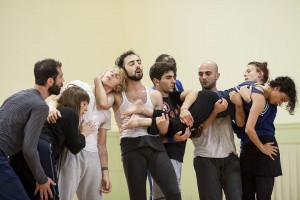
Dancers from Turkey and Armenia join members of David Dorfman Dance during creation of a new work. (Sarah Crosby/Bates College)
“Supporting the creation of new work by U.S. and international choreographers is a core principle of the festival,” says festival director Laura Faure.
Finally, like Bates itself, the festival is explicitly a place for dancers to take big leaps — metaphorically speaking — and for failure to be an occasion for learning, not reproach.
“Everyone is here to support each other,” says Bodnar. “Everyone is genuinely interested in helping the field of dance grow. You’re in a community, finally, where you feel like everyone loves what you’re doing and wants to see where you can go with it.”
